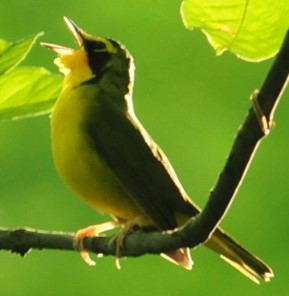Research
The Friends of Hopewell Valley Open Space encourages use of our preserves for scientific research. Our goal is to foster research that enriches our understanding of the natural world and informs our stewardship efforts.
Invasive Species
 Janet Morrison and her students from the College of New Jersey have been studying several factors associated with threats to forest health. Topics have included the relative susceptibility of particular areas to invasive species, deer impacts, and earthworm impacts.
Janet Morrison and her students from the College of New Jersey have been studying several factors associated with threats to forest health. Topics have included the relative susceptibility of particular areas to invasive species, deer impacts, and earthworm impacts.
Janet Morrison, TCNJ – Staging an invasion
Janet Morrison, TCNJ – Effects of white-tailed deer and invasive plants on the herb layer of suburban forests
Forest Structure and Presence of Breeding Birds
 Kentucky and Hooded Warblers favored forest areas with dense understory growth, which only occurs in portions of Baldpate Mountain and other areas within the Sourlands. Quantifying the amount of understory growth required provides a goal for our deer management efforts and demonstrates why these species are absent from thousands of acres of potential habitat in the Hopewell Valley.
Kentucky and Hooded Warblers favored forest areas with dense understory growth, which only occurs in portions of Baldpate Mountain and other areas within the Sourlands. Quantifying the amount of understory growth required provides a goal for our deer management efforts and demonstrates why these species are absent from thousands of acres of potential habitat in the Hopewell Valley.
Sharyn Magee and Michael Van Clef, WCAS and FoHVOS – PLANT STRUCTURE OF HOODED AND KENTUCKY WARBLER BREEDING SITES IN REGENERATING FOREST
Sharyn Magee and Michael Van Clef, WCAS and FoHVOS – Plant Structure of Hooded and Kentucky Warbler Breeding Sites in New Jersey
Forest Health
 Jay Kelly and colleagues at Raritan Valley Community college have researched the causes of declining forest understory health and how to develop ecological land management that restore New Jersey forests. Topics includes the history of invasive species in forest understories and effects of prescribed burning on NJ forests.
Jay Kelly and colleagues at Raritan Valley Community college have researched the causes of declining forest understory health and how to develop ecological land management that restore New Jersey forests. Topics includes the history of invasive species in forest understories and effects of prescribed burning on NJ forests.
Kelly J. K., Ray J., Minicuci N., Buczynski R. (2021) Effects of Prescribed Burning on Forest Understories in Northern New Jersey. Raritan Valley Community College
Kelly J. F. (2019) Regional changes to forest understories since the mid-Twentieth Century: Effects of overabundant deer and other factors in northern New Jersey. Forest Ecology and Management
Herpetological Surveys
 The presence of healthy populations of reptiles and amphibians are indicative of the overall health of an ecosystem. Amphibians are especially regarded as ‘indicator species’ because of their sensitivity to habitat destruction and the pollution of their breeding ponds. Local naturalist and educator Mark Manning volunteered to conduct herpetological surveys on FoHVOS preserves to gain insight on what species are found within the Hopewell Valley. With this knowledge we can further protect critical breeding habitats and learn more about these fascinating and at times secretive species. Below are survey reports from a few of our preserves!
The presence of healthy populations of reptiles and amphibians are indicative of the overall health of an ecosystem. Amphibians are especially regarded as ‘indicator species’ because of their sensitivity to habitat destruction and the pollution of their breeding ponds. Local naturalist and educator Mark Manning volunteered to conduct herpetological surveys on FoHVOS preserves to gain insight on what species are found within the Hopewell Valley. With this knowledge we can further protect critical breeding habitats and learn more about these fascinating and at times secretive species. Below are survey reports from a few of our preserves!
Baldpate Mountain Herpetological Report
Eames Preserve Herpetological Report
Heritage Preserve Herpetological Report
Jacob’s Creek Herpetological Report
Lichens of Mercer County
 In 2019 local researchers compiled a list of lichen and allied-fungi found in Mercer County. Included in the checklist of 147 taxa were 37 new species records for the state of New Jersey.
In 2019 local researchers compiled a list of lichen and allied-fungi found in Mercer County. Included in the checklist of 147 taxa were 37 new species records for the state of New Jersey.
Check out the paper here and see if you can identify lichen on one of our preserves, or in your backyard!
Related Topics of Interest
NJ Natural Heritage Program
Emerging Invasive Species
Connecting Children with Nature
Health Benefits of Connecting with Nature
Environmental Justice and Diversity on Public Lands
- The Nature of Americans, Major Findings
